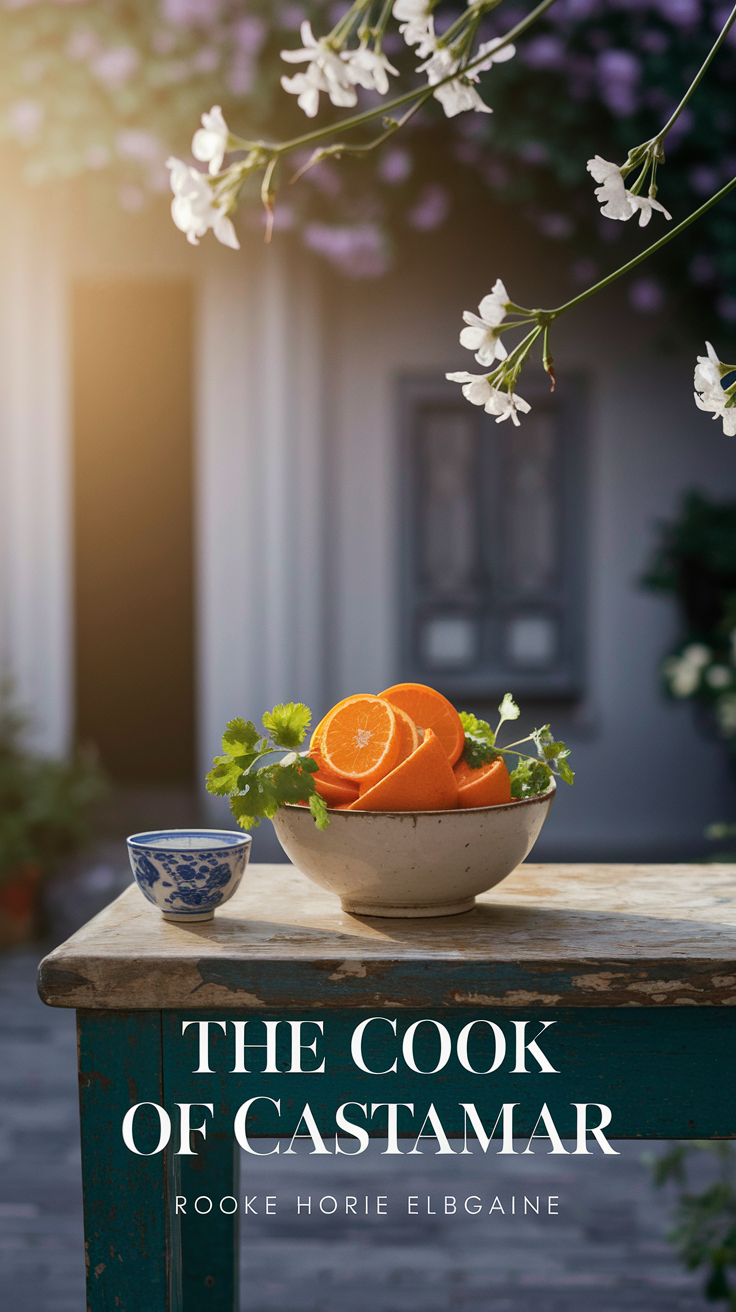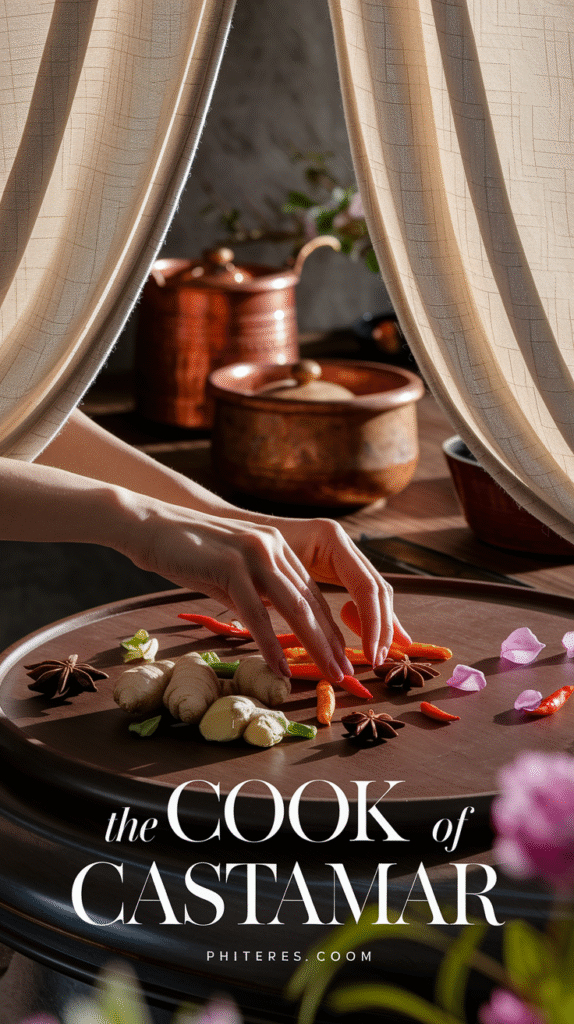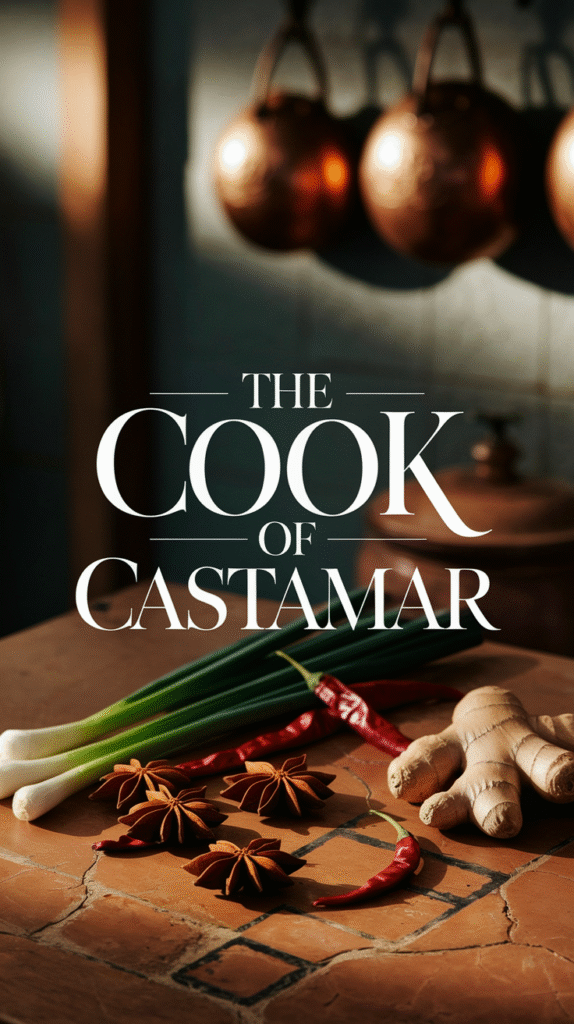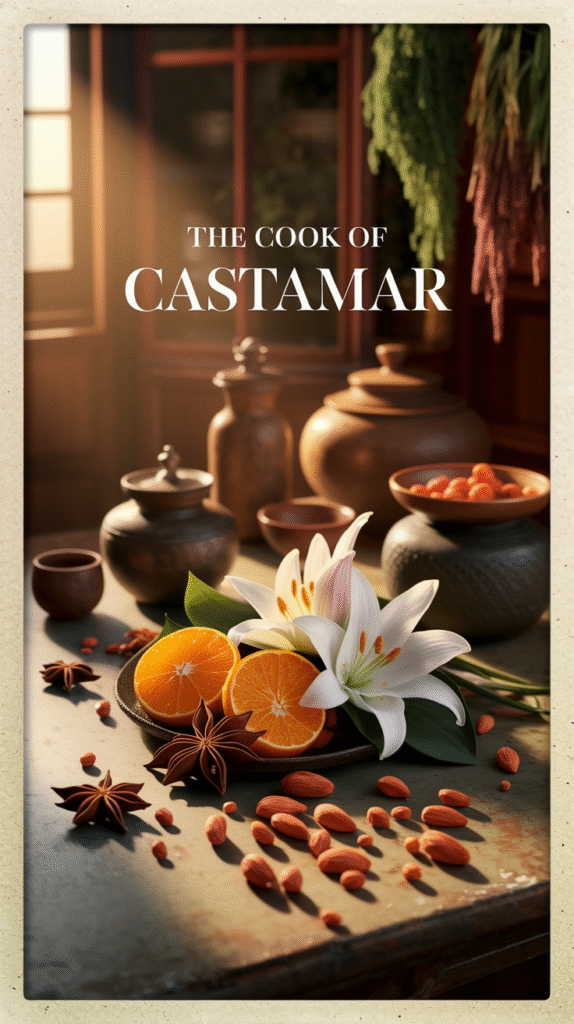The enchanting narrative of “The Cook of Castamar” elegantly intertwines the themes of love, class disparity, and the profound impact of culinary skills. Set in the early 18th century, this historical drama not only captivates viewers with its romantic twists but also highlights how essential kitchen talents are within its storytelling landscape.
Culinary skills play a central role in the tale, influencing character development and shaping relationships. The protagonist, Diego, a skilled cook, exemplifies the revolutionary changes that can come to a household through the art of cooking. His mastery of the culinary arts is depicted not just as mere craftsmanship but as a form of expression and communication. Through his food, he speaks to the emotions of others, making meals an essential part of social interaction.
To appreciate the significance of culinary skills in this narrative, let us delve into several key aspects:
- Character Development: Diego’s culinary expertise helps him rise above his humble beginnings. The kitchen becomes his sanctuary, reflecting his emotions and creativity; it showcases how a well-prepared dish can transform social status. His cooking is a bridge that connects him to Clara, the noblewoman, as they bond over the shared passion for sustenance.
- Cultural Significance: Cooking in this era is not merely a daily task but an art form. The series emphasizes traditional Spanish cuisine, which is rich, varied, and layered with history. This framework allows viewers to understand the importance of heritage, customs, and how they are expressed through food.
- Social Commentary: The class issues of the time are vividly illustrated through the kitchen dynamics. The roles of servants and nobility create a backdrop for exploring societal structures. Culinary skills serve as a tool for survival and rebellion, allowing characters like Diego to navigate and sometimes challenge these oppressive systems.
Throughout “The Cook of Castamar,” the kitchen emerges as a microcosm of society. It is where characters confront their desires, fears, and ambitions. The act of cooking is portrayed as both a labor of love and a means of symbolic resistance. The meticulously prepared meals not only satisfy hunger but also ignite passions and evoke long-buried memories.
Moreover, the authenticity with which food is represented showcases the meticulous research and attention to detail behind the series. This dedication to realistic culinary practices enhances viewer engagement, keeping an audience captivated by the aromas and flavors behind each scene. By examining how various dishes are prepared and presented, we can appreciate the skill level required to master such cuisine.
In this context, it’s worth noting a few traditional Spanish dishes featured in the series:
| Dish Name | Ingredients | Significance in the Story |
|---|---|---|
| Paella | Rice, saffron, seafood, chicken | Represents community and shared experiences; often eaten during festivities. |
| Gazpacho | Tomatoes, cucumbers, peppers | Symbolizes freshness and simplicity, highlighting social gatherings. |
| Churros | Flour, sugar, cinnamon | A treat that signifies celebration and joy amongst characters. |
The emotional depth connected to food in “The Cook of Castamar” underscores how culinary skills can transcend class boundaries. They create moments of intimacy and understanding between people from different walks of life. Diego’s ability to whip up a meal not only saves lives but also paves the way for love to blossom in the most unexpected places.
The series serves as a reminder that culinary skills are not confined to the kitchen; they resonate throughout life’s interactions. If you wish to explore more about the connection between cooking and storytelling, check out Culinary Historian for insights into how food shapes culture and narrative.
As viewers are swept away in this stirring tale, they also witness how essential culinary skills can act as a catalyst for change, exploration, and deeper human connection. “The Cook of Castamar” beautifully illustrates that food is not just sustenance; it is the thread that weaves together the fabric of our lives, rich with passion, history, and love.
Exploring Historical Contexts in Spanish Gastronomy
Spain’s culinary scene is a vibrant tapestry of flavors, techniques, and historic influences that showcase its rich gastronomic heritage. Understanding the historical contexts that shaped Spanish gastronomy can offer deeper insights into traditional dishes and contemporary adaptations. Diverse regions, cultural encounters, and economic shifts have all played pivotal roles in defining what is now recognized as Spanish cuisine.
Throughout history, Spain’s culinary landscape has been enriched by various cultures that have made their mark on the country. Here’s a glimpse into some key historical influences:
- Roman Influence: The Romans introduced new agricultural practices, crops, and the concept of the thermopolium, an early form of a restaurant. Staples like olives and grapes became part of daily life, shaping the future of Spanish cuisine.
- Visigoth Period: After the fall of the Roman Empire, the Visigoths brought their own version of farming and livestock management. Their influence on meats and preservation methods can still be felt in various Spanish charcuterie.
- Al-Andalus Influence: Perhaps the most significant impact on Spanish gastronomy came from the Moors during the Al-Andalus period. They introduced a wide range of spices, the use of rice, and techniques such as frying and stewing. Paella, a dish synonymous with Spanish culture, has its roots in this era.
- Columbian Exchange: The arrival of new world ingredients—such as tomatoes, potatoes, and peppers—transformed Spanish cuisine in the 16th century. These elements have since become essential in defining modern Spanish dishes.
- Industrial Revolution: The 19th century brought advancements that changed food preservation, transportation, and availability of ingredients. These developments allowed for greater regional variety and the emergence of what we now refer to as traditional Spanish dishes.
Each of these historical phases provided unique contributions that are still evident in Spanish cooking today. Regional variations, in particular, reflect local histories and agricultural practices, resulting in a variety of flavors you can experience throughout Spain.
In Spain, regional cuisines often tell the story of the land and its people. For instance:
| Region | Signature Dishes | Key Ingredients |
|---|---|---|
| Andalusia | Gazpacho, Jamón Ibérico | Tomatoes, Olive Oil, Garlic |
| Catalonia | Pa amb tomàquet, Escudella i carn d’olla | Bread, Tomato, Sausages |
| Basque Country | Pintxos, Bacalao al pil-pil | Bacalao, Seafood |
| Galicia | Pulpo a la gallega, Empanada gallega | Octopus, Corn Flour |
Spanish gastronomy not only reflects local ingredients but also showcases the unique cultural practices of each region. The art of preparing tapas—small plates meant for sharing—originated in various regions, emphasizing community and togetherness in meals.
Moreover, the historical context of Spanish gastronomy includes the impact of global migration. Spanish cuisine has evolved with the arrival of immigrants who have brought their culinary traditions and practices. This fusion has introduced exciting new flavors and methods, contributing to the ever-evolving food culture within Spain.
Today, many chefs strive to honor traditional Spanish dishes while incorporating modern techniques and ingredients. Restaurants rarely serve the same dish, as they adapt to current trends and local produce. For those interested in diving deeper into the world of Spanish gastronomy, various resources are available that provide insights into both traditional recipes and contemporary culinary trends.
You can explore more about Spanish gastronomy by visiting these helpful websites: Spain’s Official Tourism Website and The Fork – Spain.
This rich tapestry of culinary history not only enhances our appreciation for Spanish food but also emphasizes the significance of food as a cultural expression. Whether you’re enjoying a classic dish or a modern twist, each bite is a testament to Spain’s vibrant history.
Character Development Through Food: A Deep Dive
Food is not just a source of nourishment; it is a powerful vehicle for character development in literature, film, and even everyday life. The ways in which characters interact with food can unveil their motivations, backgrounds, and emotional states, making it an essential component in storytelling.
When we think about food in storytelling, it often embodies more than just sustenance. It serves as a medium through which characters express their identities, establish connections, and navigate societal structures. Here are some significant aspects of character development through food:
Symbolism of Food
Food often carries deep symbolic meaning. Different cuisines can represent cultural heritage or class distinctions. For instance:
- Home-cooked meals: These often symbolize warmth, comfort, and family ties.
- Exotic dishes: They can indicate exploration, adventure, or the pursuit of new experiences.
- Expensive gourmet foods: Typically associated with wealth or status, they can highlight a character’s social standing.
Cultural Contexts
Food can also reflect the cultural backgrounds of characters. For example, a character from a Mediterranean background may have a strong connection to olives, herbs, and seafood, while a character from an Asian background might have a fondness for rice and noodles. This cultural attachment influences their actions and relationships. A great illustration of this is found in The Cook of Castamar, where culinary traditions play a significant role in setting the story’s tone and deepening character connections.
Food as an Emotion Connector
Food has the unique ability to evoke emotions and memories. Characters may bond over meals, bringing a sense of community and shared experiences. Some important points to consider include:
- Celebration: Food is central to festive occasions, creating lasting memories.
- Conflict: Disagreements over food preferences can also reveal underlying tensions.
- Comfort: Characters often turn to food for solace during challenging times, illustrating their vulnerabilities.
Character Growth Through Culinary Skills
Mastering cooking can signify a character’s growth and self-improvement. The act of cooking often reflects their journey, showcasing skills like creativity, patience, and perseverance. As they become better cooks, they may also experience emotional and personal growth. For example:
| Stage of Development | Culinary Skill | Character Growth |
|---|---|---|
| Beginner | Simple Recipes | Learns to follow instructions and builds confidence. |
| Intermediate | Complex Dishes | Encounters challenges, learns from mistakes. |
| Advanced | Signature Dish | Finds personal style and identity; becomes a mentor or leader. |
Conflict and Resolution Through Food
Food often serves as a catalyst for conflict in narratives. Consider a story where a character’s dietary choices conflict with another’s beliefs or lifestyle. This setup can create tension but also offers avenues for resolution. Characters may find common ground over shared meals or work through their differences while cooking together, enhancing their relationships.
As you explore the role of food in character development, think about your experiences with it. Whether it’s the family dinner that left a lasting impression or the new dish you tried on a trip, these experiences shape our identities just as they shape characters in stories.
For more a deeper exploration of food’s impact on characters, visit Eater and Serious Eats, which delve into how culinary arts influence culture and relationships.
The elements surrounding food can open a dialogue about character development in engaging and relatable ways. From symbolism to emotional connections, the culinary world provides an incredible backdrop for exploring the intricacies of human relationships in storytelling.
The Influence of Culinary Traditions on Social Status
The culinary world is a fascinating reflection of culture, history, and social status. The dishes that grace our tables do more than just satisfy hunger; they reflect societal hierarchies, tastes, and lifestyles. Throughout history, what people eat has often been influenced by their standing in society. From extravagant feasts of the elite to the staple meals of the working class, cuisine is often synonymous with social class.
Food traditions vary widely across different cultures and classes. In aristocratic circles, for instance, lavish banquets included exotic ingredients and elaborate preparations. The nobility used meals as a means to showcase their wealth and power, often inviting notable guests to partake in such elaborate dinners. In contrast, those in lower socioeconomic classes typically relied on simple, hearty meals. When discussing how culinary traditions reflect social status, it’s essential to observe these distinctions.
Ingredients play a significant role in how culinary traditions highlight social standing. For instance:
- Luxury Ingredients: Items like truffles, saffron, and fine wines are often associated with the affluent. These delicacies not only indicate financial capability but also signify a certain level of sophistication and taste.
- Common Ingredients: Staple foods such as rice, beans, and corn are predominant in the diets of lower classes. These ingredients are economical and accessible, reflecting necessity rather than choice.
The preparation methods and presentation of food further emphasize social differences. High-status individuals often have access to professional chefs who utilize gourmet cooking techniques. Meanwhile, individuals from lower classes might rely on quicker, more utilitarian cooking practices.
Culinary traditions also influence how meals are shared within society. Social gatherings surrounding food can reinforce or highlight status. Consider these scenarios:
- Formal Dinners: High-ranking individuals are likely to host formal dinners to assert their social status. The etiquette involved in such settings often reinforces class structures.
- Casual Gatherings: In contrast, potlucks or communal meals might bring together individuals from varied backgrounds, showcasing the importance of food in building community and fostering relationships.
Moreover, food has the power to connect with identity and heritage. For example, traditional dishes often embody the history and values of a community, creating a sense of belonging. Regional cuisines can serve as a point of pride and can impact social perceptions. As cuisine evolves, it often takes on new meanings tied to innovation and cultural exchange, blurring the lines between class and taste.
Social movements have also shaped culinary traditions, leading to shifts in what is considered acceptable or desirable. During periods of economic hardship, for example, people often resort to simpler meals, yet these can also evoke a sense of resilience and resourcefulness. Analyzing your community’s culinary adaptations during challenging times can reveal much about social dynamics and status.
| Social Class | Typical Cuisine | Ingredients | Meal Settings |
|---|---|---|---|
| Upper Class | Gourmet | Truffles, Caviar, Fine Wines | Formal Dining, Exclusive Events |
| Middle Class | Varied | Seasonal Vegetables, Poultry, Pasta | Weekend Gatherings, Barbecues |
| Lower Class | Staple Foods | Rice, Beans, Root Vegetables | Casual Family Meals, Community Potlucks |
For those looking to dive deeper into the relationship between food and social structures, various resources can provide valuable insights. Websites such as Forks Over Knives and Slow Food foster discussions surrounding food sustainability and the socio-economic implications of our culinary choices.
The link between culinary traditions and social status offers a rich tapestry of insights. Your food choices and traditions are a reflection of your identity, heritage, and the broader societal structures in which you exist. By understanding these connections, we not only appreciate food more deeply but also recognize its power to shape our lives and communities.
Analyzing Themes of Love and Sacrifice in Culinary Settings
In culinary art, the themes of love and sacrifice often intertwine in remarkable ways. Chefs pour their heart into their dishes, infusing not just flavors but also emotions. This relationship between cooking, love, and sacrifice can be traced through various narratives and experiences in kitchens around the world.
When you walk into a kitchen, you might immediately feel the passion that ignites the air. Chefs work tirelessly, their hands deftly chopping ingredients while their minds whirl with the possibility of creating something extraordinary. This dedication is often rooted in love—love for food, for sharing an experience, or for a cherished family tradition. When chefs cook for others, they express affection, making love the secret ingredient in every recipe.
Culinary settings frequently showcase how love manifests through food. Moments of joy are often celebrated with cooking, whether it’s a birthday cake that brings smiles or a cozy meal shared with loved ones. You might think of how a simple dish can evoke fond memories of family dinners, reminding you of laughter and warmth. Food holds a power to connect people, a phenomenon that reflects a deep-rooted love for one another.
However, love in the culinary world is not without its sacrifices. Chefs often work long hours, sacrificing their personal lives and time with family to perfect their craft. The life of a culinary artist can be physically and emotionally demanding. This sacrifice emphasizes the lengths to which individuals will go to chase their passion and deliver culinary excellence.
The act of cooking can serve as a metaphor for sacrifice. A chef might spend hours preparing a meal, choosing the freshest ingredients, and perfecting every detail. Each choice they make reflects their dedication. These actions embody a willingness to give up time and energy for the satisfaction and joy it brings to others. It’s an investment of labor that ultimately pays off in the form of culinary masterpieces.
Consider some notable themes that arise from the intersection of love and sacrifice in culinary contexts:
- Community and Connection: Meals often bring people together. Love is expressed through recipes passed down through generations, as families gather around the table to share a meal.
- Tradition and Memory: Certain dishes evoke nostalgia, linking the past to the present through the love infused in cooking. Sacrifices made by previous generations to maintain culinary traditions are frequently honored by the current generation through their cooking practices.
- Creativity and Expression: Chefs use their culinary skills as a form of self-expression. The hours spent honing their craft reflect the sacrifices made to bring their visions to life.
- Nourishment and Care: Cooking for someone can symbolize love, as providing nourishment highlights a deep care for others’ well-being.
Filmmaking and literature often deal with these themes in culinary settings. Films like *Chef* or *Ratatouille* explore how love and passion for cooking can lead to personal growth and fulfillment. These narratives illustrate that the culinary journey is not simply about food but the emotions that inspire it. In *Ratatouille*, Remy’s love for cooking leads him to triumph against adversity, showcasing how passion can flourish even in unlikely circumstances.
Furthermore, literature has embraced similar themes. Books such as *Like Water for Chocolate* depict how food acts as a conduit for emotions, where each dish prepared reflects the cook’s feelings and sacrifices involved. These stories emphasize that cooking is not merely a task but an act of love that can lead to transformation.
Within culinary institutions, the themes of love and sacrifice resonate deeply among aspiring chefs. As they endeavor to learn and perfect their skills, they must surrender time, comfort, and often financial stability in pursuit of their dreams. This journey reflects the bittersweet reality of culinary passion—the sweet joy of creation accompanied by the sacrifices made along the way.
Ultimately, the intertwining of love and sacrifice within culinary settings resonates with anyone who has shared a meal or experienced the joy of cooking for someone else. These themes reflect universal truths about human connection and the lengths we go to nurture those we care about. Love and sacrifice in the kitchen transcend mere ingredients—they create enduring, meaningful experiences that nourish both the body and the soul.
If you’re interested in exploring more about the themes of love and sacrifice within the culinary space, consider visiting the Food & Wine website for articles on cooking, chef interviews, and stories that delve into the passion behind culinary creations.
Additionally, platforms like ChefSteps offer insights into the craft, showcasing how professional chefs balance love and sacrifice in their culinary journeys. Discovering how chefs articulate their passion for food may inspire your own cooking adventures!
Conclusion
The intricate tapestry woven throughout “The Cook of Castamar” reveals much more than a mere story of love and culinary artistry. It emphasizes the significant role that culinary skills play in shaping the characters’ lives and relationships. Through the lens of Spanish gastronomy, we see how historical contexts invite readers to explore the rich heritage of food and its essential role in society.
Food becomes a pivotal element in character development, serving as a tool for expressing emotions, desires, and social aspirations. The kitchen transforms into a stage where characters experience growth, facing dilemmas that reveal their true selves. The culinary traditions presented also highlight the stark lines drawn by social status, illustrating how food can elevate or diminish one’s standing in society.
Moreover, themes of love and sacrifice emerge vividly in the kitchen’s heart. Each meal prepared carries with it care, intent, and often the weight of personal sacrifice, emphasizing that food is not merely sustenance but a language of love. The acts of cooking and sharing food become a profound exploration of devotion and the lengths one will go to for those they cherish.
By intertwining these elements, “The Cook of Castamar” captivates its audience, encouraging a deeper appreciation for the art of cooking and its multifaceted role in human connections. The series serves as a poignant reminder that every dish tells a story, bridging the past with the present and fostering bonds that transcend time and status. As you immerse yourself in this narrative, let it inspire you to explore the culinary world within your own life, enriching your relationships along the way.







Leave a Reply